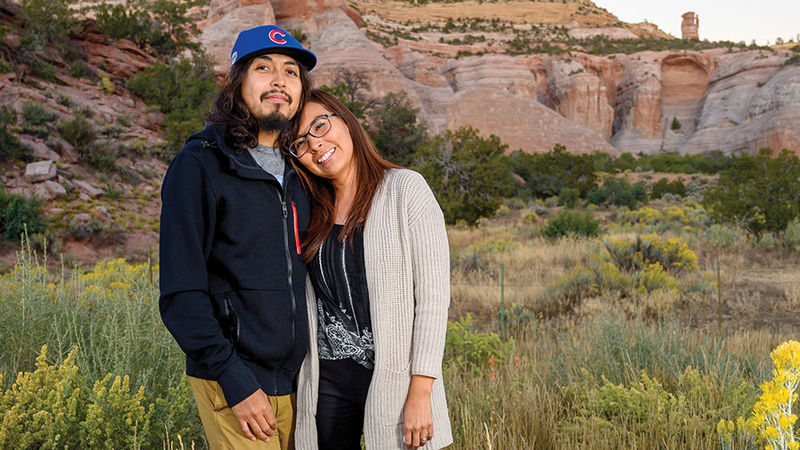Tazbah Yazzie ’10 does not like to stand out. “I am . . . well, I’m very reserved,” she tells me one morning with a small laugh, sitting at her desk and looking at the spot above my head.
Later, we cut across the sloping grounds of the school where she works. “I don’t like being in the spotlight,” she says as she walks, shielding her eyes from the sun to check her phone.
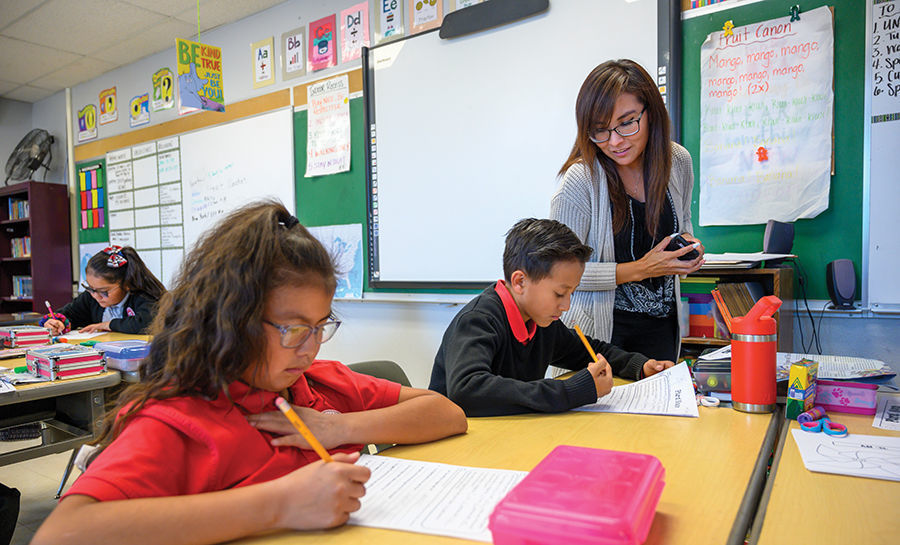
Later, we’re standing along Indian Route 12 at sunset for a photo shoot, and the sandstone formations along the roadside light up pink, then red, then orange as the sun descends the western sky. Yazzie stands in front of the glowing rocks, a petite figure with dark hair that catches red in the fading light. The photographer takes her first shot, and Yazzie looks around, taking it all in.
“I don’t like being the center of attention,” she reminds me on the drive home.
It is October, and we are heading back to St. Michael Indian School on the southwestern edge of Navajo Nation. There, Yazzie is the principal — and the center of everyone’s attention. The 34-year-old Navajo is in charge of more than 35 teachers and employees and — at last count — 359 students from pre-K to 12th grade. Yazzie knows each one by name.
“Principal” is a title Yazzie never thought she’d have, and one that still surprises her when she pauses to think about it. She rarely has the time.
Yazzie wakes each morning at 5:45 in her apartment on campus while the school is still asleep. As she dresses for the day, cars start to move along the surrounding blue hills, heading to and from the nearby towns: Window Rock, Arizona, just five minutes down the road, Fort Defiance to the north, or Gallup, New Mexico, 30 minutes to the east. Yazzie feeds her rabbits, turns on the news for a second, turns it off, says goodbye to her husband, Cody ’08, skips breakfast, heads outside and walks 20 feet from her apartment to her office door, where aides and teachers are starting to trickle in.
Today light breaks over the hills to the east of St. Michael around 7. Leaves on the trees surrounding the school are tinged yellow, and the morning is cool enough that Yazzie’s breath rises in a cloud. By 7:30, the principal is standing in the parking lot with a megaphone, directing the first wave of families in cars. The school bus arrives. The youngest students, dressed in red-and-black uniforms, sprint into their classrooms and yell and laugh and leave a haze of reddish dust in their wake. Then it’s time for Yazzie to lead morning chapel, guzzle coffee from the break room, meet with teachers, respond to emails, remember to eat lunch, check on her rabbits, respond to more emails, lead more meetings and help out with after-school programs.
By 8 p.m., around the time the last sports practice ends and the last student leaves campus, Yazzie is in her apartment and exhausted. Then she’ll work on her homework toward her online master’s degree — her second graduate program, this one in educational leadership from Arizona State University. She’ll let the rabbits run around their enclosure, greet Cody when he gets home from work and maybe go on a run. She’ll fall asleep around 1 a.m.
Yazzie never expected any of this — this job, this life, these responsibilities. “This position, it’s all-encompassing,” she says. “Everything goes by you. The responsibility of everything — the teachers, the students, the parents.” She has worked at St. Michael for a decade, teaching fourth grade for four years, then serving as assistant principal for four years. She is now in her second year as principal.
Yazzie knows that she represents her school and its 117 years of history, so she speaks carefully. When she talks about her jam-packed schedule, it’s with a calm that might seem effortless — until you realize how easy it would be not to be calm, with the rabbits and family members and teachers and students who rely on her every day.
But that focus on others carries her through. Call it devotion, or resilience. It’s what makes Yazzie stand out — whether she likes it or not.
St. Michael’s campus is a patchwork of red-roofed, brick buildings perched on a cluster of hills. From an upper-story classroom, you can see for miles — roads, scattered homes, power lines, grassy rolling hills, green bushes and faraway orange cliffs that rise sharply. On clear fall days, the sky arcs overhead in a smooth, deep blue.
The Navajo people have lived in this region for hundreds of years. Dinétah — the ancestral homeland of the Diné, or Navajo, people — is traditionally marked by four sacred mountains to the east, west, north and south, in what are now Colorado, New Mexico and Arizona. The federal reservation that is the Navajo Nation — the largest of its kind in the United States — stretches for more than 27,000 square miles.
The tribe resisted colonial incursion for the most part until 1862, when Col. James Carleton of the U.S. Army led a government-sponsored campaign to kill and deport the Navajo and Mescalero Apache peoples from their homelands. Between 1863 and 1866, some 10,000 Navajo were forced into an internment camp at Fort Sumner in eastern New Mexico, where they lived in abject conditions; many starved and died. The area is known today as Hwéeldi, the place of suffering, the time of exile recalled as one of overwhelming grief.
The Treaty of Bosque Redondo, signed in 1868, ended the imprisonment and established the reservation, yet also stipulated that all Navajo children attend federally run boarding schools. The children were taken from their homes, forced to cut their hair and learn English, and were often abused. Native communities and schools continue to reckon with the trauma inflicted by this attempt at cultural genocide.
Enter St. Katharine Drexel, a wealthy heiress from Philadelphia who shocked her peers when, feeling called by God to serve the most neglected in American society, she entered religious life. In 1891, she founded the Sisters of the Blessed Sacrament for Indians and Colored People. Her mission schools aimed to evangelize, but with cultural sensitivity and concern for the marginalized. She would establish 12 schools for Native Americans, including St. Michael, and 50 schools for African Americans, among them Xavier University of Louisiana.
Drive just a half-mile down a back road from the St. Michael campus, winding through Navajo willows, and you’ll find Drexel’s first project at the school — a squat brick building with a large cross out front. She purchased 200 acres around a trading post in 1896 and sent three Franciscan friars to form St. Michael’s Mission and start a school, which they began building in March 1902. The following December, their first students — 21 children, wrapped in blankets as their wagon struggled through snow — arrived.
Few of the schools Drexel founded have endured, and although the Sisters of the Blessed Sacrament still own properties, the presence of vowed religious at those schools has all but vanished.
When Yazzie steals an hour one day at lunchtime, we drive about 15 minutes to Tséhootsooí Middle School in Fort Defiance, where a small woman waves excitedly from the parking lot. Yolanda Yazza, Yazzie’s mother, is beaming. She’s wearing embroidered, Notre Dame-themed earrings.
Tazbah Yazza Shortey was born on September 15, 1987, in Fort Defiance. Her grandmother, who worked at the Navajo records office and was said to carry a pistol, named this newest grandchild. In English, Tazbah means “everyone scattered.”
Yazzie’s mother and older brother Hank live in a trailer with walls covered in Hank’s vibrant, painted landscapes. From a crowded shelf, Yolanda carefully extracts a photograph of her grandfather, Peter Yazza, taken at a 1971 Veterans Day celebration. He was a Navajo Code Talker in World War II.
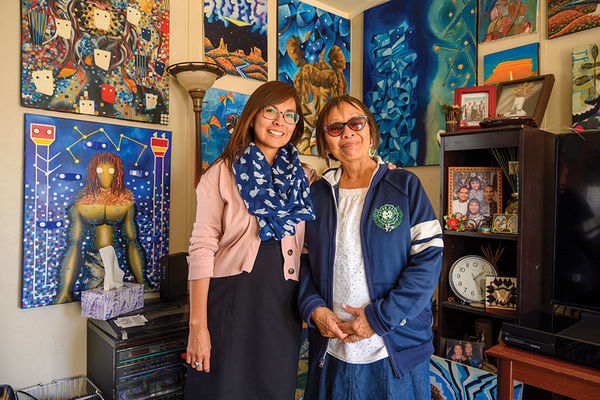
Tazbah and her two brothers moved a few times when they were growing up, bouncing between trailer homes in Window Rock and Fort Defiance and living off their single mother’s salary as a public school teacher. Tazbah’s father was a farmer, and neither woman says much about him, except that Yazza remembers how he’d come home from a long day of work in the fields with dust coating his eyelashes. Their plans to marry fell through. “My dad was here and there, but not really here,” Yazzie tells me later.
It wasn’t easy. But Yazzie grew up sensitive and curious and, for the most part, happy. She remembers playing outside constantly. The youngest of the three siblings, she begged her brothers to play with her. “Tazzi was her brothers’ tail. When she was little, she would be pedaling on her tricycle trying to keep up with them,” her mother says, laughing.
Yazzie loved school, where things came easily to her. Given her older brothers’ bad experiences in public high schools, their mother decided to send her to Holbrook High School, a boarding school more than an hour away. At Holbrook, Yazzie excelled. “I think the only class I didn’t get an A in was physics,” she says. “I think I got — and I was devastated — I think I got a C or a B. And that was the worst thing ever.”
College was never a question — it was a certainty. “I always told her, you need to stay in school,” Yazza tells me. “I told her, you know, ‘Don’t do what I did.’ I did the two years and I left, and I should’ve just stayed in school and finished up. I didn’t get through with my schooling until . . . I went back to school when Tazbah was 8 months old. She was in the cradleboard,” she says.
One day, her mom took a day off work to drive Yazzie five hours to Phoenix for a college fair, where they were the only American Indian family in the room. A kind Notre Dame admissions officer, Gilbert Martinez ’84, hung back to talk to Yazzie and her mom after the crowd dispersed. Before that, Notre Dame hadn’t been on Yazzie’s radar; after meeting Martinez, she decided to apply. When she realized she couldn’t afford the $500 enrollment fee, she called Martinez in a panic. He told her he’d take care of it.
Yazzie was accepted, was a Gates Millennium and Balfour-Hesburgh scholar and aimed to be a doctor. She would live in a big city. “I wanted to get away from here as far as I could,” Yazzie recalls. “Looking back at it now, that’s pretty sad. But I was in that teenaged, 18-year-old mindset. So that’s one of the reasons I chose Notre Dame, because it was far.
“I had it all mapped out,” Yazzie says. “And then, you know, that all changed my first year at Notre Dame.”
In the early years of St. Michael School, students spent half their day in classes and half their day working on campus. Tuition was free until 1946, when the high school opened, charging $10 per semester. The school changed to all-girls boarding in the 1960s, and then went co-ed again sometime in the 1980s, and later stopped boarding students altogether.
“The biggest transition in the last decade is definitely seeing religious staff being replaced by local, lay staff,” says Renee Tsinnie, the school’s director of corporate, foundation and public relations. Tsinnie arrived in 2009, when about 20 Sisters of the Blessed Sacrament still worked at the school. Over time, the nuns died, retired or were moved to other posts. Sister Amelia Bréton, SBS, a short, curly-haired nun from the Dominican Republic who teaches religion classes, is now the only sister living on campus.
For a while, the nuns were replaced by volunteers, often white and new to the area. They rarely stayed longer than a year. Hiring more full-time Navajo staff has made the enterprise more sustainable, says Tsinnie. Derrick Terry, a parent of St. Michael students, says he had no Natajo teachers when he attended in the 1990s. “Now, my kids have a lot of Native teachers,” he says. “It makes a difference.”
St. Michael now ranks among the best private schools in the region. The St. Michael Cardinals are the only 1A program in Arizona to take four state titles in sports, the athletic director says. Mykl Greene, the energetic STEM teacher, has his students working with 3-D printers in the new Maker’s Place Lab, established last year. The school continues to expand and improve, recently adding a preschool and providing breakfast for students up to eighth grade.
St. Michael can also be a haven for students on the reservation, where life is not always easy. According to the latest census estimates, 35 percent of Navajo Nation families live below the poverty line. A quarter of rural Native American families say that lack of high-speed internet access is a problem for their families, and nearly half struggle to pay for medical bills, housing or food. Some St. Michael students drive two hours with their families to attend every day. Nearby public schools grapple with limited funds, poor infrastructure and difficulty recruiting teachers.
“A lot of people think that we’re rich because we go here. But we’re not,” one St. Michael student tells me. According to Tsinnie, 90 percent of the students receive at least one scholarship — many have two or three. On Navajo Nation, where just 8 percent of residents have an undergraduate degree, St. Michael sends more than 95 percent of its graduating seniors to college.
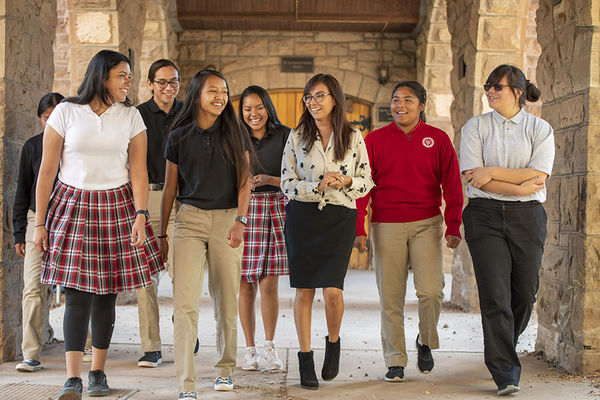
Sitting on a bench outside the chapel with a group of high school students, I asked how many are planning on going to college. Everyone raises a hand.
Halfway through her freshman year at Notre Dame, Yazzie thought of leaving. At a predominantly white, affluent university, she could count all the Native American students she knew on two hands. “It was lonely,” she says. “It was such a culture shock. Just very different.”
She had made some friends in the Balfour Scholars orientation that August. But they lived in Breen-Phillips — she lived in Lyons — and the friendships were still new, and she was shy. “And I think because I wasn’t doing well academically, that was also weighing on me,” she says. Floundering in her rigorous pre-med courses, Yazzie called her mother nearly every day. “I was at that point of like, ‘Should I come back? I don’t want to do this anymore.’ And it was difficult. I felt really isolated,” she says. “And I would talk to my mom, and tell her, ‘I just miss home. I don’t feel good about it.’
“She just told me, ‘Stick it out,’” Yazzie remembers. “That was just my mindset. I was just like, ‘Tough it out. Tough it out, and get over it, and do your work. Focus in on what you want at the end of the year.’” There was no magic fix. But things got better, bit by bit. That spring, she dropped the pre-med track and picked up a sociology major. She transferred dorms. She discovered places where she felt at home: that room with the pool table in the basement of LaFortune and the Grotto. In her sociology classes, Yazzie started to enjoy school again. She also got involved with the Native American Student Association. (By senior year, she was its president.)
That first spring, a mutual friend introduced her to Cody Yazzie, a charming Zahm Hall resident three years ahead of her. He loved Star Wars and his Chicago Cubs hat. They both loved animals. He was Navajo, too. When they met, more than 1,500 miles away from home, they realized that they lived within 15 minutes of one another on the reservation. They started dating in 2007, the summer after Yazzie’s freshman year.
“My life now basically just flipped 180 degrees from what I thought would happen,” Yazzie says, laughing. “It’s just kind of ironic how, from an 18-year-old to a 22-year-old, how much you can grow and mature.”
She knew as a junior, having tutored grade school students at the South Bend Police Boxing Club, that she wanted to teach. She also realized she wanted to teach on the reservation.
Partly, it was a longing. Yazzie missed the orange rocks and the way everything smelled when it rained. Partly, it was her desire to live near Cody — who, unlike her, had always known that he wanted to return.
During her senior year, one of her professors, Brian Collier, suggested Yazzie look into St. Michael Indian School. Cody, who had attended St. Michael, also encouraged her to apply. She sent in her application not expecting much — she didn’t have a teaching degree, after all. She wasn’t Catholic. She wasn’t sure they’d want her.
And then something happened that would transform the next 10 years of her life: She got the job.
Even as the principal, Yazzie still subs in classes when she can. This morning, to give a teacher a break to catch up on grading, she leads a fourth grade class in a lesson on plural nouns. “How do we make ‘leaf’ plural?” she asks, keeping her voice level and turning to write on the whiteboard. “Butterfly ends in what letter?” Yazzie walks around the desks, checking answers and bending low to talk quietly with students, heads bowed, adding “s” and “ies” in pencil.
When she arrived at St. Michael as a fourth grade teacher, Yazzie’s credentials and skill in the classroom stood out. When Tracie Lee, the school’s first Navajo principal, promoted Yazzie to assistant principal in 2014, Yazzie knew she was being groomed to be principal. “But everything happens sooner rather than later,” Yazzie says. In July 2018, one of Lee’s successors stepped down unexpectedly. Within days, Yazzie had the job.
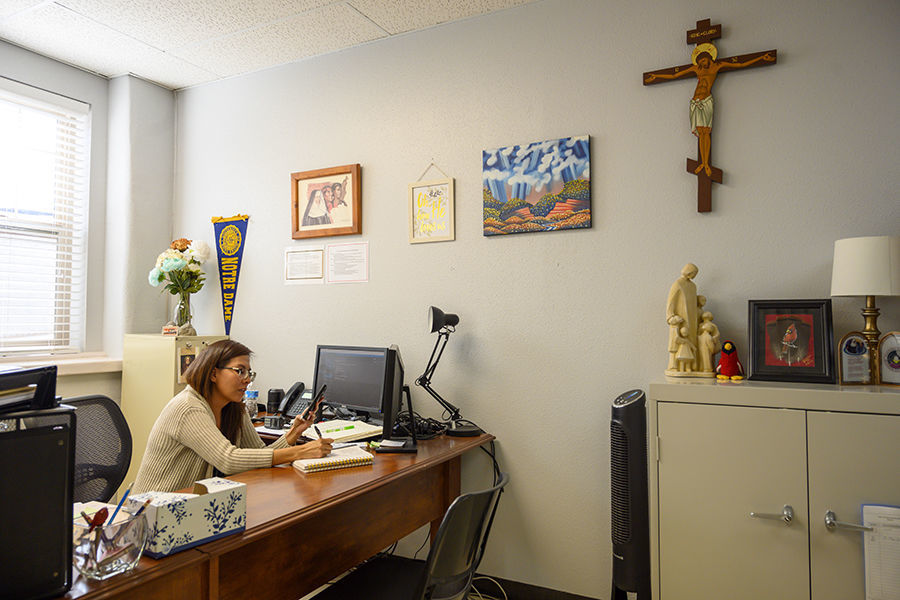
Parents couldn’t believe she was in charge. “A lot of people would be like, ‘Oh, you look like you’re still in high school,’” Yazzie recalls, a rare note of frustration in her voice. The school president, Dot Teso, and Lee assured Yazzie that she was more than qualified. Both women continue to be invaluable mentors to her, Yazzie says. Still, when things didn’t go according to plan, Yazzie would be furious with herself.
“I definitely am a perfectionist when it comes to my work,” she says. “I have to perform at my best at everything I do. And if I’m not performing at my best,” she pauses, laughs, and her voice gets softer — “I guess I’m very critical of myself.” She laughs again. “Dot has conversations with me and tells me it doesn’t have to be perfect. And that’s something that I’m working on, too, is delegating, and not needing to have control.”
Sitting in her office one evening, I raise the issue of Yazzie’s age to Teso. She interrupts before I can get the question out. “Oh, yeah, no,” she says, waving the question away. She knew that some people thought Yazzie was too young or had too little experience. “I don’t buy that,” she says. “Get Tazbah’s experience, her brains and her desire. And her drive. And then come talk to me.”
The high school bathrooms are messy — really messy. Someone broke a water fountain. It’s unacceptable. Yazzie has heard complaints from teachers, she says.
It’s Wednesday morning, and we’re in the chapel. Light falls through tall panes of painted glass, casting the spare white walls purple and yellow. Mass just ended, but Yazzie has held back the older students for a lecture. Some in the front row are jiggling their legs or staring into the distance, itching to leave their seats.
“Can we do better?” Yazzie asks, looking out sternly over the pews.
“Yes,” comes a reluctant response.
Later, in her office, Yazzie collapses into her chair and leans back. “I don’t like having to do that,” she says. “I want to make them feel that ‘Yes, I am here, we love you, we want you to be here.’ But also, ‘What can you do to make a better choice? How can you recover from it?’ Because I don’t want any child to feel like they can’t recover.
“And I try — and this is a phrase from Dot — to ‘show them who you are through God’s grace,’” Yazzie says. “Everything I do is for them.”
Yazzie converted to Catholicism when she was assistant principal, having grown up Episcopalian. She rarely went to Mass at Notre Dame, but when she started working at St. Michael, she would sit in the pews with her fourth graders, and she started to feel something. She fell in love with the singing, the Psalms, the call-and-response. “I think it was through the Mass, where I was like, OK, I really do want to become Catholic,” Yazzie says. “I could feel it.”
So she did her homework. She asked questions of Teso, of the sisters, of the Franciscan priests in the nearby parish. She went through the preparation program and was received into the Church at the Easter vigil Mass.
Yazzie also asked questions of Cody’s mom, Arita, who was raised in Navajo traditions. She hadn’t learned much about Navajo beliefs as a child — the language and culture that she picked up came mostly from her public school curriculum. “But what I’ve seen, especially with Cody’s mom, is that a lot of things can go hand in hand with the Catholic faith,” Yazzie says. “You know, they’re not the same thing, but there are similarities in both.”
“There’s a really fine line, when you have your Catholic faith on this side and then you have our traditions on the other,” Arita tells me. “It’s a lot for our younger generations to take in. But Tazbah is very cool about all that. I’m very proud of her.” To refine her thinking, says Arita, “She goes to reliable people to say, ‘OK, I have an issue here.’” That curiosity — and her fluency in her traditional and Catholic faiths — helps her be a more empathetic leader for her students, Yazzie says. At St. Michael, 60 percent of the students are Catholic and 29 percent practice both the Catholic and the Navajo faith. Sometimes, students will need exemptions for traditional ceremonies. Girls going through puberty ceremonies, for instance, will be out of class for several days. “So, for things like that, it’ll be an excused absence,” Yazzie says.
“I’m not in any way an expert of the Navajo traditional faith, and I don’t want to come off that way. But you know, I’m attuned to it,” she continues. “Just having that sensitivity is key.”
Converting to Catholicism also meant another thing: a church wedding. “That was a big deal for us,” Yazzie says. Cody and Tazbah married on December 15, 2018. The church where they married, Mary, Mother of Mankind, was built in the 1930s by the Franciscan friars just a stone’s throw from the original St. Michael’s Mission. One of the people who helped build it was Cody’s great-great-grandfather. To get married in a church built by family — that was special. “Cody was their first family member to get married in this church,” Yazzie says. “It was just kind of full circle.”
It was a busy fall at the school. In November, the “What Would You Fight For?” ad campaign featured Notre Dame architecture students prescribing a new campus plan, including an athletic facility. The school also kicked off a capital campaign to raise funds for that campus, with Teso introducing Yazzie as the “first Navajo Catholic principal” in the school’s history. That distinction — first, Navajo, Catholic — makes Yazzie, as Teso often reminds her, the living embodiment of St. Katharine Drexel’s dream.
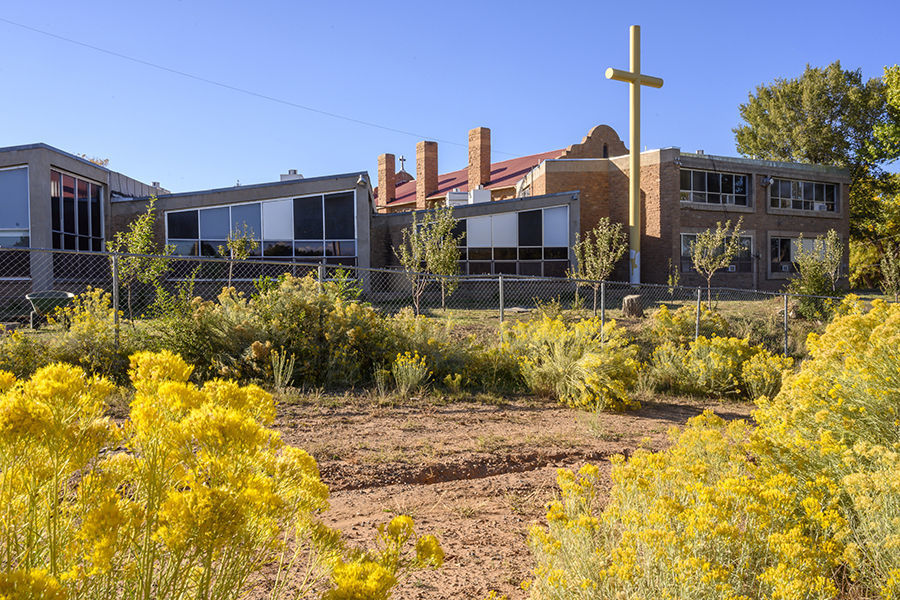
“I didn’t feel the pressure in that way,” she says. “But it kind of hits me every now and then.” She falters, “It’s just — I guess sometimes, I don’t, like I said, I don’t like attention drawn on myself. But I also remind myself that I’m in this position, and it is a significant position. So, I need to realize that yes, I am this person.” After a moment she continues, “Sometimes it just hits me — that I am, and this is, a big deal.”
Katharine Drexel’s dream. Yazzie wipes away a hint of a tear, and draws her next breath. “So, yes. That impacts me, too.”
There are moments throughout each day that confirm, for Yazzie, why she came home. “When I talk about coming here from Notre Dame, it was like a calling,” Yazzie says. “I felt that calling. I felt inside that this is where I was meant to be. That feeling that’s like, This is where you’re growing.”
She feels it when she’s sitting in chapel with her students, or when she’s driving on Interstate 40 for dinner with Cody. She feels it when she’s with her rabbits, Daphne and Whiskey, whose eating, sleeping and playing habits she could talk about for hours. “Those moments remind me that’s why I’m here,” she says. When she has the time to stop by her apartment for lunch, she’ll check in on the rabbits and video-call Cody at his job as a service technician for the Navajo Tribal Utility Authority, so that he can say hi to the bunnies while they nibble at bits of food or hop around in their pens.
Seconds alone in the apartment are always precious. And they’re often just moments squeezed into long, busy days. Sitting in her office, I ask what she does for herself, to relax. “Myself? Oh, for myself, like, stress relief?” she asks, with a laugh like an exclamation point. She starts to explain how she likes TV shows like The Real Housewives or YouTube videos, things that don’t require much brainpower — but a fire alarm cuts her sentence short.
In a second, she’s on her feet, talking into her walkie-talkie and marching out to the playground where students are already filing outside, flanked by frazzled teachers. It was a false alarm, maybe caused by some electrical repairs.
Looking out over the playground, Yazzie takes a beat and assesses the chaos. Then she starts directing traffic through her megaphone. “Quiet down, please!” The students fall quiet. Only a few minutes are left in the day, so Yazzie decides to dismiss the students on the spot. When she says the word, the playground explodes with chatter. High schoolers and kindergartners head in every direction at once, aiming for lockers or the parking lot or the line of cars that’s forming around the curve of a hill.
One eager kindergartner breaks into a run across the courtyard, and Tazbah turns just in time to see the girl trip and tumble onto the concrete. She rushes over. “Kaydence, are you OK?” Kaydence bounds back up again, startled but unharmed. Holding the girl’s hand and gripping her megaphone in the other, Yazzie walks with her, slowly, step by tiny kindergartner step. They walk until they’re a few paces from the door. Yazzie lets go of her hand, then looks on as the little girl shuffles the last few feet. The door swings shut. Yazzie watches it close. She pauses another second, just to be sure.
Then she turns and heads back to her office. School is done for the day, but she has more work to do.
After graduation, Nora McGreevy, a native of South Bend, interned at The Boston Globe and was at Washingtonian magazine.
